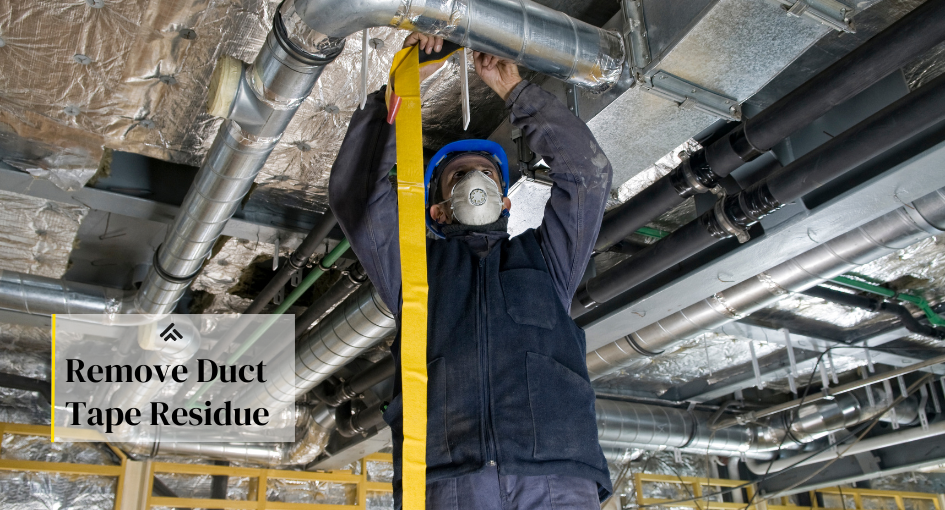Duct tape can be a lifesaver when it comes to home repairs, quick fixes, or even creating DIY crafts. However, as handy as duct tape may be, one of the biggest frustrations is the sticky residue left behind once you remove it.
This pesky residue can seem almost impossible to remove and can leave your surfaces looking unsightly and grimy. Whether it’s on your walls, furniture, or floors trying to remove duct tape residue can feel like an endless battle with no solution in sight. But fear not!
I will explore various methods and tips on effectively removing duct tape residue from different surfaces without damaging them. Say goodbye to stubborn sticky patches because by the end of this post, you’ll have all the knowledge you need to eliminate any unwanted duct tape remnants successfully!
Step-by-Step Guide on How I Remove Duct Tape Residue
Removing duct tape residue can be a pesky task, but with the right approach, you can eliminate it efficiently. Here are several methods you can try to remove duct tape residue in Duct Estimating depending on the materials you have at hand and the surface from which you’re trying to remove the residue:
Warm Water and Soap
Materials Needed:
Warm water, liquid dish soap, a cleaning cloth or a sponge.
Procedure:
To effectively remove residue, create a solution by mixing warm water with a few drops of liquid dish soap in a container. Submerge a clean cloth or sponge into the mixture, ensuring it is damp but not dripping. Gently apply the dampened cloth or sponge to the residue, lifting it off the surface using circular motions. This method is particularly suitable for delicate surfaces that require a gentle approach to cleaning.
Oil-Based Substance
Materials Needed:
Cooking oil, baby oil, or mineral oil; a clean cloth.
Procedure:
To effectively remove adhesive residue, apply a small amount of oil onto a clean cloth. Gently rub the oil onto the affected area and let it sit for a few minutes. The oil works by breaking down the adhesive, facilitating easier removal. This versatile method can be used on various surfaces, including skin, ensuring a hassle-free cleaning experience.
Rubbing Alcohol or Isopropyl Alcohol
Materials Needed:
Rubbing alcohol, a clean cloth.
Procedure:
To effectively remove residue, moisten a clean cloth with rubbing alcohol. Gently dab or rub the affected area until the residue begins to lift off. Rubbing alcohol is particularly effective on hard surfaces such as metal or glass. However, exercise caution when using it on plastics or painted surfaces, as it has the potential to cause damage to these materials.
Vinegar
Materials Needed:
White vinegar, a clean cloth.
Procedure:
To effectively remove adhesive residue, wet a clean cloth with vinegar. Gently place the vinegar-soaked cloth over the affected area and let it sit for a few minutes to allow the vinegar’s mild acid to break down the adhesive. After soaking, softly rub the residue away using the cloth. This method is gentle on surfaces and helps dissolve adhesives effectively without causing damage.
Commercial Goo Remover
Materials Needed:
Commercial adhesive remover (e.g., Goo Gone).
Procedure:
Follow the manufacturer’s instructions for applying the product to the residue. These specialised removers are meticulously formulated for this precise purpose and have shown to be highly effective. However, as a precautionary measure, conducting a patch test on a small, inconspicuous area beforehand is advisable to verify that they do not cause any unintended damage to the surface. It’s always better to be safe than sorry when dealing with residues and surfaces.
Tips:
Here are some helpful tips for you:
-
Always test the chosen method on a small, inconspicuous area first to ensure it does not damage the surface.
-
Be gentle when rubbing or scraping to avoid damaging the surface beneath the residue.
-
After removing the residue, wash the area with warm, soapy water (if applicable) to remove any remaining cleaner or residue.
Choosing the right method depends on the sensitivity of the surface and the materials you have available. Always proceed with caution to avoid any damage.
To read more articles visit BloggersRanking
Conclusion
Removing duct tape residue may seem like a daunting task, but with the right methods and tools, it can be easily done. I’ve discussed various techniques to effectively get rid of stubborn residue. It’s important to note that patience and persistence is key when dealing with duct tape residue, as it may take multiple attempts to completely remove it. Additionally, always remember to test a small area first before applying any method to avoid damaging the surface. Whether you’re dealing with residue on your car, furniture, or walls, these tips will surely come in handy. So the next time you find yourself struggling to remove that pesky duct tape residue, refer back to this blog post and try out some of these techniques for a hassle-free cleaning experience!


